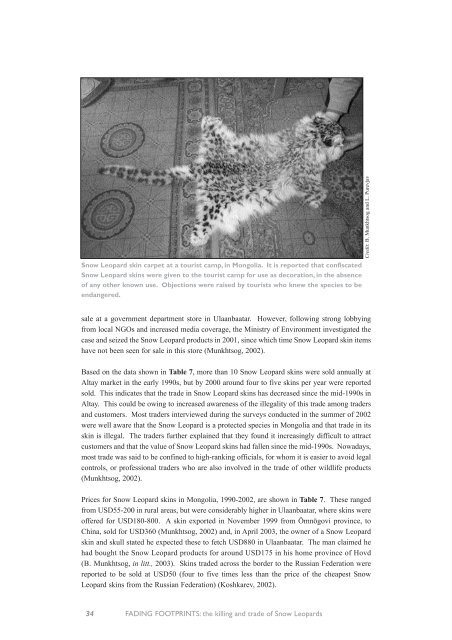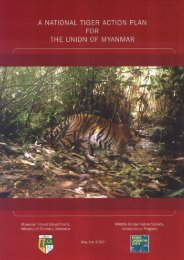Download - Global Tiger Initiative
Download - Global Tiger Initiative
Download - Global Tiger Initiative
You also want an ePaper? Increase the reach of your titles
YUMPU automatically turns print PDFs into web optimized ePapers that Google loves.
Snow Leopard skin carpet at a tourist camp, in Mongolia. It is reported that confiscated<br />
Snow Leopard skins were given to the tourist camp for use as decoration, in the absence<br />
of any other known use. Objections were raised by tourists who knew the species to be<br />
endangered.<br />
Credit: B. Munkhtsog and L. Purevjav<br />
sale at a government department store in Ulaanbaatar. However, following strong lobbying<br />
from local NGOs and increased media coverage, the Ministry of Environment investigated the<br />
case and seized the Snow Leopard products in 2001, since which time Snow Leopard skin items<br />
have not been seen for sale in this store (Munkhtsog, 2002).<br />
Based on the data shown in Table 7, more than 10 Snow Leopard skins were sold annually at<br />
Altay market in the early 1990s, but by 2000 around four to five skins per year were reported<br />
sold. This indicates that the trade in Snow Leopard skins has decreased since the mid-1990s in<br />
Altay. This could be owing to increased awareness of the illegality of this trade among traders<br />
and customers. Most traders interviewed during the surveys conducted in the summer of 2002<br />
were well aware that the Snow Leopard is a protected species in Mongolia and that trade in its<br />
skin is illegal. The traders further explained that they found it increasingly difficult to attract<br />
customers and that the value of Snow Leopard skins had fallen since the mid-1990s. Nowadays,<br />
most trade was said to be confined to high-ranking officials, for whom it is easier to avoid legal<br />
controls, or professional traders who are also involved in the trade of other wildlife products<br />
(Munkhtsog, 2002).<br />
Prices for Snow Leopard skins in Mongolia, 1990-2002, are shown in Table 7. These ranged<br />
from USD55-200 in rural areas, but were considerably higher in Ulaanbaatar, where skins were<br />
offered for USD180-800. A skin exported in November 1999 from Ömnögovi province, to<br />
China, sold for USD360 (Munkhtsog, 2002) and, in April 2003, the owner of a Snow Leopard<br />
skin and skull stated he expected these to fetch USD880 in Ulaanbaatar. The man claimed he<br />
had bought the Snow Leopard products for around USD175 in his home province of Hovd<br />
(B. Munkhtsog, in litt., 2003). Skins traded across the border to the Russian Federation were<br />
reported to be sold at USD50 (four to five times less than the price of the cheapest Snow<br />
Leopard skins from the Russian Federation) (Koshkarev, 2002).<br />
34 FADING FOOTPRINTS: the killing and trade of Snow Leopards

















